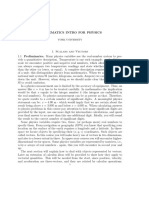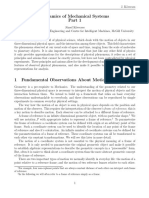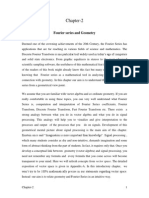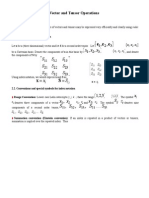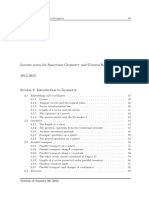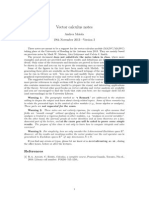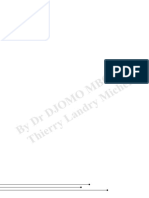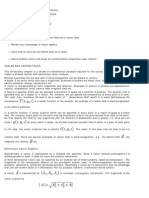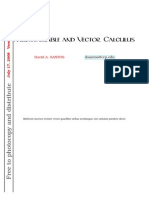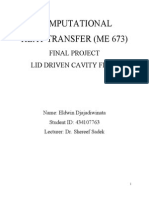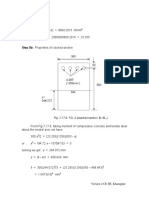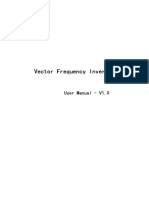Module 10: Scaler Fields, Limit and Continuity Lecture 28: Series of Functions (Section 28.1)
Uploaded by
scrModule 10: Scaler Fields, Limit and Continuity Lecture 28: Series of Functions (Section 28.1)
Uploaded by
scrModule 10 :
Scaler fields, Limit and
Continuity
Lecture 28 : Series of functions [Section 28.1]
Objectives
In this section you will learn the following :
The notion of distance in
and
Notions of neighborhoods of points.
Notion of convergence of sequences in
28 .1 Spaces
and
and
In these notes we shall develop many concepts that helps us understanding functions of several
variables: limits, continuity, differentiability, problems of maxima minima, and integration. We shall see
how these concepts resemble, and are different, that of a single variable. Since most of the theorems
that can be proved for functions of two variables can be extended to functions of three or more
variables, we confine our analysis to two/three variables only.
28.1.1The spaces
and
Recall that for the function of one variable, the underlying set was
variables, corresponding role is played by the set
the set of all ordered pairs
plane. For
, where
, the Cartesian product of
. Geometrically,
with itself:
is represented by points in the
represents the Cartesian coordinates of the point
an orthogonal system of coordinate axes. Similarly,
where
, the set of real numbers. For two
in plane with respect to
space can be represented by
called the Cartesian coordinates or components of a point.
and
Figure 1. Coordinates of a point in
In the language of vectors, a point
final point
in
represents the vector
, with initial point
and
Vectors can be added, scalar multiplied component wise. For example for vectors
the vector sum is
Figure 2. Scalar multiplication and addition of vectors
and the multiplication of
by a scalar
is
The origin represents the vector
Various properties of these operations are given in Exercise 1. We identify points in
vectors they represent. A vector
is also represented as
, where
with the
are
vectors of unit length along the respective coordinate axes.
The notion of 'closeness' between points on
can be described in terms of the magnitudes of
vectors. We
do this for points in
For points in
these can be defined by adding suitable terms corresponding
to the third component.
Similar to the situation in
For
the
that is the set of all points
definition.
28.1.2Definition:
(i)
For a point
we use the above notion of distance to define the neighborhoods in
in
with
-neighborhood of a point in
was the open interval
which are at most at a distance
from
. This motivates the next
is called the norm or magnitude of the vector.
(ii)
For
, the distance between then, denoted by
is defined to be
Figure 3. Norm of a vector
(iii)
For vectors
and
, the dot product of these vectors is defined to be
28.1.3 Theorem:
and scalars
For vectors
the following holds:
(i)
(ii)
(iii)
(iv)
(v)
(vi)
(vii)
(viii)
where
(ix)
is the angle between the vectors
. This is called Cauchy- Schwarz inequality.
(x)
(xi)
(xii)
and
if and only if
This is called triangle- inequality.
(xiii)
Proof:
All the statements are easy to prove.
28.1.4Definition:
and
For
, the
-circular neighborhood of the point
, which are at a distance at most
This is also called an open ball at
center
from
is the set of all points
, i.e., the set
with radius
. The open ball
is called a deleted open ball and will be denoted by
without the
. Thus,
Figure 4. Open ball and deleted open ball.
,
For points
and
Recall that in
the notion of an sequence helped us to understand the various properties of functions of
and
a single variable. We can do the same in
28.1.5Definition:
is an ordered collection of points
An sequence in
sequence in
and
, we say sequence
in
We write it as
converges to a point
. In analogy with
if the distance between
goes to zero, that is
We can write it in terms of
that
We write this as
definition. This means that given
there exists an
such
An equivalent criterion is given by the following theorem.
28.1.6Theorem:
Then, the following are equivalent:
Let
(i)
(ii)
and
Practice Exercises
(1)
Prove theorem 28.1.3.
(2)
For
Module
, and
10 :
Scaler
fields,
Limit and
, prove the following:
(i)
(ii)
.
(iii)
for every
(iv)
implies
(v)
(3)
Give examples to show that for
need not imply
(4)
Cross product of vectors
Let
The cross product of
with
is the vector,
, given by
(A convenient way to remember this is to write
Prove the following statements for
.
(i)
(ii)
(iii)
(iv)
(v)
(vi)
as a determinant:)
and
(vii)
(viii)
, where
if and only if
(ix)
(5)
For
point
-rectangular neighborhood at
Show that every circular neighborhood of a
in
is said to be Cauchy if for all
there exists
. Prove the equivalence of the following:
is convergent
(i)
and
(ii)
is Cauchy in
(iii)
includes a circular neighborhood and vice-versa.
A sequence
for all
for some
and
let
This is called an
(6)
is the angle between
are Cauchy sequence in
.
Recap
In this section you have learnt the following
The notion of distance in
and
Notions of neighborhoods of points.
Notion of convergence of sequences in
and
Continuity
Lecture 28 : Series of functions [Section 28.2]
Objectives
In this section you will learn the following :
The notion of functions with domains in
Notions of contour lines and level curves.
and
such that
28 .2 Functions of two or three variables:
Functions of two or more variables arise in almost every field. For example, in topography, the height of
the land depends on the two coordinates that gives its location. The reaction rate of two chemicals A and
B depends upon their concentrations A and B, and the temperature t. The pressure at a place can be
regarded as a function of time, temperature and the location of the place. The amount of food grown in
India depends upon the amount of rain and the amount of fertilizer used. The strength of gravitational
attraction between two bodies depends on their masses and the distance between them.
28.2.1Definition:
For
, a function
is called a function of two (or three) variables. The set
is called the range of the functions . If
for which
is called its domain and the set
is given by a formula, then the set of all those points
is defined is called the natural domain of
28.2.2 Examples:
(i)
Let
Then
, has natural domain the set
,
and its range is the interval
(ii)
Let
Then, the natural domain of
is the set
and its range its range is the set
Recall that, a function of one variable can be represented geometrically as a curve in the plane. We may
try to represent a function of two variables by a 'surface' in
.
28.2.3Definition:
Let
be a function of two variables. Let
The set
is called the graph of the function
One can get an idea of
the graph of a function
as follows:
28.2.4Definition:
For a function
of two variables, for each
the set
Figure 1. Graph of a unction of two variables
gives a curve in the
-plane. This is called a level curve of the function
set of points in the domain of
where
takes a constant value
28.2.5Examples:
(i)
For
the level curves of
are
These are the lines through the origin with slope
at
. This is the
Figure 2. Level curves for
(ii)
For
the level curves are
These are circles centered at origin with radius
only for
. Thus, they are defined
Figure 3. Level curves for
Another concept that helps us to visualize
the graph of a function, is as follows:
28.2.6Definition:
For every
, the contour line for a function
is the curve in 3-space given by
Contour line indicates the points on the surface
section of the surface
by the plane
28.2.7Examples:
(i)
For
the contour line for
is
that is
Figure 4. Contour lines for
(ii)
For
the contour line for
is the circle
that are at a given height
.
or it is the
Figure 5. Contour lines for
28.2.8Note:
(i)
Like taking sections of a surface by planes perpendicular to
the
surface by planes perpendicular to
the surface.
(ii)
-axis or
-axis, one can also consider sections of
-axis. These sections are care
-traces (
For functions of three variables, contour lines generalize to contour surface ( or also called level
surfaces ).
For example for
the level surfaces are
spheres concentric about the origin in the
coordinate system.
CLICK HERE TO SEE AN INTERACTIVE VISUALIZATION - APPLET
Practice Exercises
(1)
For the following functions find the natural domain and range:
(i)
(ii)
(iii)
.
(iv)
Answers
(2)
For the following functions, sketch the contour lines corresponding to
(i)
(ii)
(iii)
(3)
-traces) of
For the following, sketch the level curves for the following:
(i)
(ii)
.
(iii)
(iv)
Answers
Recap
In this section you have learnt the following
The notion of functions with domains in
Notions of contour lines and level curves.
and
You might also like
- Uploading Excel Spreadsheets Into Ebusiness Suite: OracleNo ratings yetUploading Excel Spreadsheets Into Ebusiness Suite: Oracle13 pages
- Project Element Response: Project Name Today's Date Project Start Date Target Completion DateNo ratings yetProject Element Response: Project Name Today's Date Project Start Date Target Completion Date2 pages
- EE731 Lecture Notes: Matrix Computations For Signal ProcessingNo ratings yetEE731 Lecture Notes: Matrix Computations For Signal Processing21 pages
- PolycoPhys1ENPMouzali2223VF_250112_182749No ratings yetPolycoPhys1ENPMouzali2223VF_250112_18274958 pages
- Lecture Notes For Spacetime Geometry and General RelativityNo ratings yetLecture Notes For Spacetime Geometry and General Relativity33 pages
- Tensor, Stress, and Strain: Transformation of Vectors and Tensors in Cartesian Coord I N A Te SystemsNo ratings yetTensor, Stress, and Strain: Transformation of Vectors and Tensors in Cartesian Coord I N A Te Systems27 pages
- Calculus For Scientist and Engineers - Franke Griggs Norris - CompressedNo ratings yetCalculus For Scientist and Engineers - Franke Griggs Norris - Compressed893 pages
- Concept of Tensors Deformation of A Body Stress Equilibrium Equations Constitutive Equations Principles From Work and Energy Homework ReferencesNo ratings yetConcept of Tensors Deformation of A Body Stress Equilibrium Equations Constitutive Equations Principles From Work and Energy Homework References19 pages
- Vector and Tensor Analysis: Fig. 1.1 3-Dimensional Cartesian Coordinate System With Unit VectorNo ratings yetVector and Tensor Analysis: Fig. 1.1 3-Dimensional Cartesian Coordinate System With Unit Vector3 pages
- Extensions of The Frame Alignment Technique and Their Use in The Characteristic Locus Design MethodNo ratings yetExtensions of The Frame Alignment Technique and Their Use in The Characteristic Locus Design Method11 pages
- Physics 1 Book 2024 Faculty of Comp. & Information, (2)No ratings yetPhysics 1 Book 2024 Faculty of Comp. & Information, (2)116 pages
- MATH 234 Third Semester Calculus: Z F (X, Y)100% (2)MATH 234 Third Semester Calculus: Z F (X, Y)197 pages
- Matrix Algebra For Beginners, Part II Linear Transformations, Eigenvectors and EigenvaluesNo ratings yetMatrix Algebra For Beginners, Part II Linear Transformations, Eigenvectors and Eigenvalues16 pages
- Introduction To Calculus of Vector FieldsNo ratings yetIntroduction To Calculus of Vector Fields46 pages
- Lesson 6: Functions of One and More VariablesNo ratings yetLesson 6: Functions of One and More Variables3 pages
- Determinants and Diagonalization - Linear AlgebraNo ratings yetDeterminants and Diagonalization - Linear Algebra44 pages
- Solution 1:: Step 1: Properties of Plain Concrete SectionNo ratings yetSolution 1:: Step 1: Properties of Plain Concrete Section1 page
- 7.17.5 Calculation of Short-Term Deflection: I I I I - M / M) (Z / D) (X/D) (B/B) INo ratings yet7.17.5 Calculation of Short-Term Deflection: I I I I - M / M) (Z / D) (X/D) (B/B) I1 page
- 2.3.7 Test 3 With Solutions: Version 2 CE IIT, KharagpurNo ratings yet2.3.7 Test 3 With Solutions: Version 2 CE IIT, Kharagpur1 page
- Step 6: Checking of The Requirements of IS 456:) (PermNo ratings yetStep 6: Checking of The Requirements of IS 456:) (Perm1 page
- 7.17.9 Practice Questions and Problems With Answers: F o W FNo ratings yet7.17.9 Practice Questions and Problems With Answers: F o W F1 page
- 2.3.8 Summary of This Lesson: TQ.6: Give Four Reasons To Justify The Design of Structures by Limit State MethodNo ratings yet2.3.8 Summary of This Lesson: TQ.6: Give Four Reasons To Justify The Design of Structures by Limit State Method1 page
- 12 GB Operating Instructions Uluf ModelsNo ratings yet12 GB Operating Instructions Uluf Models27 pages
- John Cod - Coding Languages - SQL, Linux, Python, Machine Learning. The Step-By-Step Guide For BeginnersNo ratings yetJohn Cod - Coding Languages - SQL, Linux, Python, Machine Learning. The Step-By-Step Guide For Beginners472 pages
- Case Study 4: The Collapse of Nokia's Mobile Phone BusinessNo ratings yetCase Study 4: The Collapse of Nokia's Mobile Phone Business26 pages
- C Lab Programs: Tapasya Gutha Gitam Cse B EditNo ratings yetC Lab Programs: Tapasya Gutha Gitam Cse B Edit38 pages
- Uploading Excel Spreadsheets Into Ebusiness Suite: OracleUploading Excel Spreadsheets Into Ebusiness Suite: Oracle
- Project Element Response: Project Name Today's Date Project Start Date Target Completion DateProject Element Response: Project Name Today's Date Project Start Date Target Completion Date
- EE731 Lecture Notes: Matrix Computations For Signal ProcessingEE731 Lecture Notes: Matrix Computations For Signal Processing
- Lecture Notes For Spacetime Geometry and General RelativityLecture Notes For Spacetime Geometry and General Relativity
- Tensor, Stress, and Strain: Transformation of Vectors and Tensors in Cartesian Coord I N A Te SystemsTensor, Stress, and Strain: Transformation of Vectors and Tensors in Cartesian Coord I N A Te Systems
- Calculus For Scientist and Engineers - Franke Griggs Norris - CompressedCalculus For Scientist and Engineers - Franke Griggs Norris - Compressed
- Concept of Tensors Deformation of A Body Stress Equilibrium Equations Constitutive Equations Principles From Work and Energy Homework ReferencesConcept of Tensors Deformation of A Body Stress Equilibrium Equations Constitutive Equations Principles From Work and Energy Homework References
- Vector and Tensor Analysis: Fig. 1.1 3-Dimensional Cartesian Coordinate System With Unit VectorVector and Tensor Analysis: Fig. 1.1 3-Dimensional Cartesian Coordinate System With Unit Vector
- Extensions of The Frame Alignment Technique and Their Use in The Characteristic Locus Design MethodExtensions of The Frame Alignment Technique and Their Use in The Characteristic Locus Design Method
- Physics 1 Book 2024 Faculty of Comp. & Information, (2)Physics 1 Book 2024 Faculty of Comp. & Information, (2)
- Matrix Algebra For Beginners, Part II Linear Transformations, Eigenvectors and EigenvaluesMatrix Algebra For Beginners, Part II Linear Transformations, Eigenvectors and Eigenvalues
- Master the Fundamentals of Electromagnetism and EM-InductionFrom EverandMaster the Fundamentals of Electromagnetism and EM-Induction
- Solution 1:: Step 1: Properties of Plain Concrete SectionSolution 1:: Step 1: Properties of Plain Concrete Section
- 7.17.5 Calculation of Short-Term Deflection: I I I I - M / M) (Z / D) (X/D) (B/B) I7.17.5 Calculation of Short-Term Deflection: I I I I - M / M) (Z / D) (X/D) (B/B) I
- 2.3.7 Test 3 With Solutions: Version 2 CE IIT, Kharagpur2.3.7 Test 3 With Solutions: Version 2 CE IIT, Kharagpur
- Step 6: Checking of The Requirements of IS 456:) (PermStep 6: Checking of The Requirements of IS 456:) (Perm
- 7.17.9 Practice Questions and Problems With Answers: F o W F7.17.9 Practice Questions and Problems With Answers: F o W F
- 2.3.8 Summary of This Lesson: TQ.6: Give Four Reasons To Justify The Design of Structures by Limit State Method2.3.8 Summary of This Lesson: TQ.6: Give Four Reasons To Justify The Design of Structures by Limit State Method
- John Cod - Coding Languages - SQL, Linux, Python, Machine Learning. The Step-By-Step Guide For BeginnersJohn Cod - Coding Languages - SQL, Linux, Python, Machine Learning. The Step-By-Step Guide For Beginners
- Case Study 4: The Collapse of Nokia's Mobile Phone BusinessCase Study 4: The Collapse of Nokia's Mobile Phone Business



